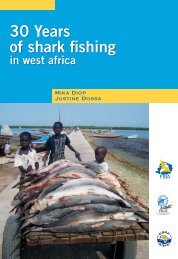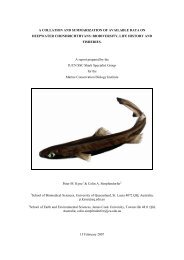Magazine of the species survival Commission specialist Group - IUCN
Magazine of the species survival Commission specialist Group - IUCN
Magazine of the species survival Commission specialist Group - IUCN
Create successful ePaper yourself
Turn your PDF publications into a flip-book with our unique Google optimized e-Paper software.
nagoya defines future for life on earth<br />
SOS Press Launch – Monique Barbut, Robert Zoellick, Kirsi Sormunen, Jean-Christophe Vié and Julia Marton-Lefèvre. © Dena Cator<br />
groups such as mosses in GSPC considerations and<br />
indicated that groups like algae and fungi (including lichenforming<br />
<strong>species</strong>) could be more appropriately served by<br />
separate strategies <strong>of</strong> <strong>the</strong>ir own. In paragraph 5, <strong>the</strong> text<br />
reads “While <strong>the</strong> Strategy addresses <strong>the</strong> plant kingdom with<br />
main focus on higher plants, and o<strong>the</strong>r well-described groups<br />
such as bryophytes and pteridophytes, Parties, o<strong>the</strong>r<br />
Governments and o<strong>the</strong>r relevant stakeholders may consider<br />
developing conservation strategies for o<strong>the</strong>r groups such as<br />
algae and fungi (including lichen-forming <strong>species</strong>).”<br />
Singapore also emphasized <strong>the</strong> importance <strong>of</strong> focusing<br />
attention on plants in <strong>the</strong> marine environment and this<br />
wording was incorporated into paragraph 4 <strong>of</strong> <strong>the</strong> document.<br />
Marine and coastal biodiversity<br />
The final document that was adopted on this agenda item<br />
can be found in L.42. Many <strong>of</strong> <strong>the</strong> <strong>IUCN</strong> Marine Programme’s<br />
recommendations were included in <strong>the</strong> final text, for<br />
example, reference to <strong>the</strong> Global Ocean Biodiversity Initiative<br />
(GOBI) in paragraph 35 relating to <strong>the</strong> Executive Secretary<br />
working with o<strong>the</strong>rs to facilitate availability and interoperability<br />
<strong>of</strong> <strong>the</strong> best available marine and coastal<br />
biodiversity data sets, and <strong>the</strong> Executive Secretary working<br />
with o<strong>the</strong>rs to establish a repository for scientific and<br />
technical information and experience related to <strong>the</strong><br />
application <strong>of</strong> <strong>the</strong> scientific criteria on <strong>the</strong> identification <strong>of</strong><br />
EBSAs in annex I <strong>of</strong> decision IX/20, as well as o<strong>the</strong>r relevant<br />
compatible and complementary nationally and intergovernmentally<br />
agreed scientific criteria that shares<br />
information and harmonizes with similar initiatives. The<br />
original document is here (p. 102).<br />
Invasive Alien Species<br />
The final document that was adopted on Invasive Alien<br />
Species can be found in L.35. An Ad Hoc Technical Expert<br />
<strong>Group</strong> (AHTEG), which <strong>IUCN</strong> is a part <strong>of</strong>, was created to<br />
fur<strong>the</strong>r explore issues on invasive alien <strong>species</strong>. The<br />
mandate <strong>of</strong> <strong>the</strong> AHTEG is “to suggest ways and means,<br />
including, inter alia, providing scientific and technical<br />
information, advice and guidance, on <strong>the</strong> possible<br />
development <strong>of</strong> standards by appropriate bodies that can be<br />
used at an international level to avoid spread <strong>of</strong> invasive alien<br />
<strong>species</strong> that current international standards do not cover, to<br />
address <strong>the</strong> identified gaps and to prevent <strong>the</strong> impacts and<br />
minimize <strong>the</strong> risks associated with <strong>the</strong> introduction <strong>of</strong><br />
invasive alien <strong>species</strong> as pets, aquarium and terrarium<br />
<strong>species</strong>, as live bait and live food with <strong>the</strong> present terms <strong>of</strong><br />
reference”. Ge<strong>of</strong>frey Howard led this issue at CBD COP 10<br />
and Piero Genovesi, Chair <strong>of</strong> <strong>the</strong> Invasive Species Specialist<br />
<strong>Group</strong>, was also instrumental in contributing to <strong>the</strong><br />
preparation and discussions for this agenda item.<br />
<strong>IUCN</strong> communications at CBD COP 10<br />
<strong>IUCN</strong> released a number <strong>of</strong> key stories at CBD COP 10,<br />
among <strong>the</strong>m:<br />
1. an update <strong>of</strong> <strong>the</strong> <strong>IUCN</strong> Red List at CBD COP 10 that had<br />
incredible pick-up by media;<br />
2. an assessment <strong>of</strong> all vertebrates in <strong>the</strong> world;<br />
3. <strong>the</strong> launch <strong>of</strong> <strong>the</strong> Save Our Species (SOS) Fund;<br />
4. a story on plant conservation in Asia; and<br />
5. an article on invasive <strong>species</strong> and climate change.<br />
32 • <strong>species</strong> 52
















